|
|
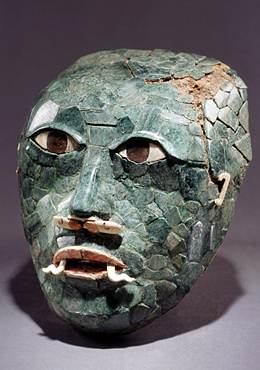
|
The expiration of the king's breath soul is portrayed on this mosaic funerary mask by the white shell curls on each side of the mouth. This remarkably naturalistic mask was worn by a member of the Calakmul elite, whose tomb was located below the floor of a building atop the first tier of Structure II, the site's largest pyramid.
Mosaic Funerary Mask |
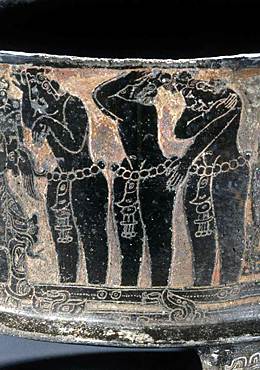
|
This burial scene vessel (detail) depicts the entombment of a lord. Glyphs state that he has begun his after-death journey by "entering the road" and passing into the underworld. Six young women stand in the underworld waters, mourning his death. Three of them are seen here in gestures of woe.
Tripod Vessel with Burial Scene |
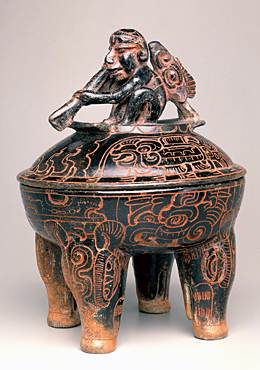
|
This lidded vessel depicts a figure, or soul, seated in a canoe and paddling through the underworld's black waters. A fish perches on the back of the figure, whose head and back are incised with the sign k'in (sun). These markings connect the figure with the Sun God and the sun itself, whose diurnal journey provided a metaphor for human life. In Maya belief, the sun accompanied dead souls on their journey and the two became a single entity.
Lidded Tripod with Figure of Canoer |
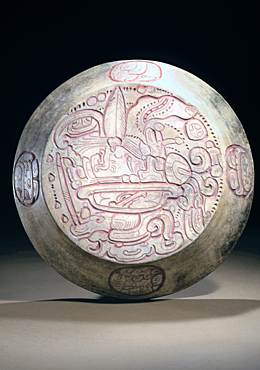
|
The life cycle of the maize plant also provided a metaphor for life after death. It was expressed in the allegorical life cycle of the Maize God, who was decapitated by the Lords of the Underworld. His sons, the Hero Twins, retrieved his bones and resurrected him, and he danced out of the underworld through a split in the earth's surface. On this incised cache dish lid, the Maize God's head rests on an offering plate shaped like a canoe.
Cache Vessel Lid |
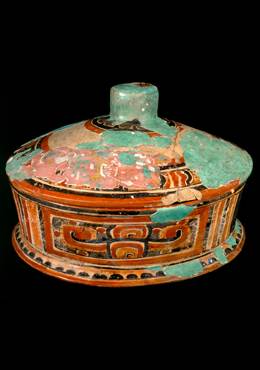
|
Many Early Classic slip-painted vessels were decorated with post-fire stucco and paint. The decoration was used to coat the vessel in fields of color, such as the red and green seen on this lidded dish from Holmul, or to create pictorial imagery, iconic motifs, and hieroglyphic texts. Most of the vessels seem to have been redecorated just before they were placed in burials, although the reasons for this are unknown.
Lidded Dish. |
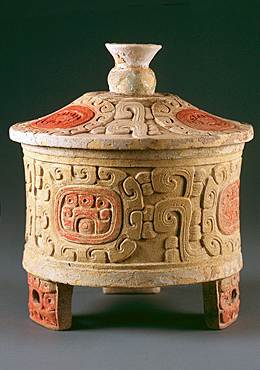
|
The Hunal tomb at Copan was discovered beneath Structure 16, a primary pyramid and temple in Copan's acropolis and the focus of rituals of ancestor veneration throughout the Classic period. The skeletal remains of K'inich Yax K'uk' Mo' were found deep inside the structure, in vaulted tomb chambers. Among the objects on the tomb's floor was this finely carved, lidded tripod, which came from a workshop in the central Peten lowlands, most likely Tikal.
Lidded Tripod with Carved Decoration |
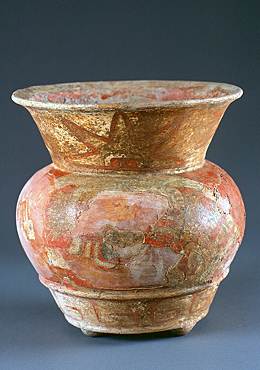
|
This tall vase, decorated with post-fire stucco and paint, was also found in the tomb of K'inich Yax K'uk' Mo'. It comes from a workshop in the Mexican highlands, perhaps at a site in the modern state of Puebla, where Teotihuacan's characteristic Thin Orange pottery was made.
Vessel |
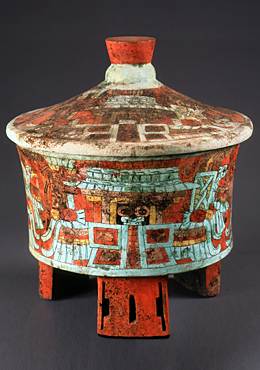
|
Painted organic containers and eighteen pottery vessels, some filled with food offerings, were placed in the Magarita tomb at Copan and its antechamber. One of these, the appropriately named "Dazzler Vase," was made in highland Mexico. It appears to depict the Hunal Platform underlying Copan's Structure 16. The goggle-eyed figure inside the temple may be K'inich Yax K'uk' Mo'.
Lidded Tripod Vessel. |
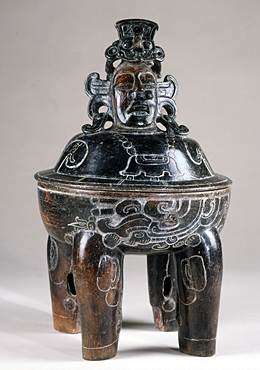
|
Funerary imagery on this blackware vessel from a tomb at Calakmul includes its four supports, which are modeled to resemble peccary heads, and two Vision Serpents incised on its body. Both motifs recall the decoration on the vessel with the canoer (#3 in this series of images). The lid's modeled head and incised decoration depicts a human figure, likely the deceased lord, his upper arms marked with crossed-band symbols of death and the underworld.
Lidded Vessel with Potrait of King |
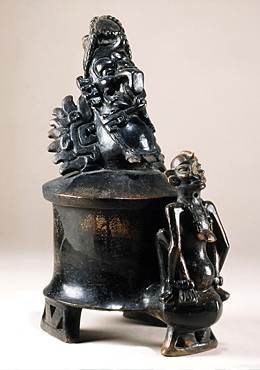
|
The lavishly furnished tomb thought to be that of ruler Tuun K'ab' Hix contained some of the most elaborately modeled blackware pottery ever produced at Calakmul. The Principal Bird Deity seen atop this tripod vessel is a recurring theme on these funerary ceramics, suggesting that this avian supernatural had special symbolic meaning for the site and its ruling dynasty.
Lidded Vessel with Principal Bird Deity and Figure. |
top home |
Copyright 2005 Los Angeles County Museum of Art